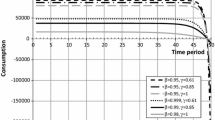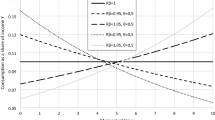Abstract
We address intertemporal utility maximization under a general discount function that nests the exponential discounting and the quasi-hyperbolic discounting cases as particular specifications. Under the suggested framework, the representative agent adopts, at some initial date, an optimal behavior that shapes her consumption trajectory over time. This agent desires to take a constant discount rate to approach the optimization problem, but bounded rationality, under the form of a present bias, deviates the individual from the intended goal. As a result, decreasing impatience will end up dominating the agent’s behavior. The individual will not be aware of her own time inconsistency and, therefore, she will not revise her plans as time elapses, what makes the problem relatively simple to address from a computational point of view. The general discounting framework is used to approach a standard optimal growth model in discrete time. Transitional dynamics and stability properties of the corresponding dynamic setup are studied. An extension of the standard utility maximization model to the case of habit persistence is also considered.




Similar content being viewed by others
Notes
As it evident, instead of presenting the discount function through (2) and (3), we can equivalently display it under the more compact form \(D_{EB}(t,s)=\left\{ \begin{array}{l@{\quad }l} 1&{}\text { if }t=s \\ \beta ^{\theta _{1}+(1-\theta _{0})(t-s)}&{}\text { if }t=s+1,s+2,... \end{array} \right. \)The first presentation is preferred for reasons that have to do with the clarity of exposition.
Appendix A describes the steps required to arrive to this relation.
This equation is derived under the assumption that the utility function is logarithmic, \(u(c)=\ln c\).
See Appendix D for the derivation of this equation.
See Heer and Maussner (2005) for a more general presentation of the utility function with habit persistence and corresponding analytical treatment.
See Appendix E for the derivation of this equation.
See Walde (2011) for an extensive discussion on intertemporal optimization techniques, including dynamic programming.
References
Akerlof GA (1991) Procrastination and obedience. Am Econ Rev 81:1–19
Almenberg J, Gerdes C (2011) Exponential growth bias and financial literacy. IZA discussion paper n\(^{o}\) 5814
Barro RJ (1999) Ramsey meets Laibson in the neoclassical growth model. Q J Econ 114:1125–1152
Benhabib J, Bisin A, Schotter A (2010) Present-bias, quasi-hyperbolic discounting, and fixed costs. Games Econ Behav 69:205–223
Bialaszek W, Ostaszewski P (2012) Discounting of sequences of delayed rewards of different amounts. Behav Process 89:39–43
Bleichrodt H, Rohde KIM, Wakker PP (2009) Non-hyperbolic time inconsistency. Games Econ Behav 66:27–38
Coury T, Dave C (2010) Hyperbolic’ discounting: a recursive formulation and an application to economic growth. Econ Lett 109:193–196
Dasgupta P (2008) Discounting climate change. J Risk Uncertain 37:141–169
Dimitri N (2005) Hyperbolic Discounting can represent consistent preferences. University of Siena, Department of Economics working paper n \(^{o}\) 466
Drouhin N (2009) Hyperbolic discounting may be time consistent. Econ Bull 29:2549–2555
Farmer JD, Geanakoplos J (2009) Hyperbolic discounting is rational: valuing the far future with uncertain discount rates. Cowles Foundation Discussion Papers n \(^{o}\) 1719
Gollier C (2010) Expected net present value, expected net future value, and the Rmasey rule. J Environ Econ Manag 59:142–148
Gollier C, Weitzman M (2010) How should the distant future be discounted when discount rates are uncertain? Econ Lett 107:350–353
Gong L, Smith W, Zou H (2007) Consumption and risk with hyperbolic discounting. Econ Lett 96:153–160
Graham L, Snower DJ (2008) Hyperbolic discounting and the Phillips curve. J Money Credit Banking 40:427–448
Groom B, Hepburn C, Koundori P, Pearce D (2005) Declining discount rates: the long and the short of it. Environ Resour Econ 32:445–493
Heer B, Maussner A (2005) Dynamic general equilibrium modelling—computational methods and applications. Springer, Berlin
Hepburn C, Duncan S, Papachristodoulou A (2010) Behavioural economics, hyperbolic discounting and environmental policy. Environ Resour Econ 46:189–206
Japelli T (2010) Economic literacy: an international comparison. Econ J 120:F429–F451
Kahneman D, Tversky A (1979) Prospect theory: an analysis of decision under risk. Econometrica 47:263–292
Laibson D (1997) Golden eggs and hyperbolic discounting. Q J Econ 112:443–478
Laibson D (1998) Life-cycle consumption and hyperbolic discount functions. Eur Econ Rev 42:861–871
Loewenstein G, Prelec D (1992) Anomalies in intertemporal choice: evidence and an interpretation. Q J Econ 57:573–598
Lusardi A (2008) Financial literacy: an essential tool for informed consumer choice?’ NBER working paper n \(^{o}\) 14084
Noor J (2011) Intertemporal choice and the magnitude effect. Games Econ Behav 72:255–270
O’Donoghue T, Rabin M (1999) Doing it now or later. Am Econ Rev 89:103–124
Phelps ES, Pollak RA (1968) On second-best national saving and game-equilibrium growth. Rev Econ Stud 35:185–199
Pollak RA (1968) Consistent planning. Rev Econ Stud 35:201–208
Rasmussen EB (2008) Some common confusions about hyperbolic discounting. Indiana University, Kelley School of Business, working paper of the department of Business Economics and Public Policy n \(^{o}\) 2008–2011
Rubinstein A (2003) Economics and psychology? The case of hyperbolic discounting. Int Econ Rev 44:1207–1216
Stango V, Zinman J (2009) Exponential growth bias and household finance. J Finance 64:2807–2849
Strotz RH (1956) Myopia and inconsistency in dynamic utility maximization. Rev Econ Stud 23:165–180
Walde K (2011) Applied intertemporal optimization. Mainz University Gutenberg Press, Mainz
Xia B (2011) A simple explanation of some key time preference anomalies. Can J Econ 44:695–708
Acknowledgments
We thank participants and organizers of the 6th Annual Meeting of the Portuguese Economic Journal and the comments of colleagues from the Business Research Unit of the Lisbon University Institute. We gratefully acknowledge, as well, the valuable and insightful comments of two anonymous referees. Alexandra Ferreira-Lopes and Orlando Gomes acknowledge financial support from PEst-OE/EGE/UI0315/2011. Alexandra Ferreira-Lopes and Tiago Neves Sequeira acknowledge support from FCT, Project PTDC/EGE-ECO/102238/2008.
Author information
Authors and Affiliations
Corresponding author
Electronic supplementary material
Below is the link to the electronic supplementary material.
Appendices
Appendix A: Computation of equation (6)
To derive Eq. (6), observe that (4) and (5) might be presented, respectively, as
and
Under the assumption of exponential discounting bias, (18) and (19) come
and
Now, we rearrange the terms in Eq. (20) in order to display an equivalent expression,
Replacing \(U_{s+1}(c)\) as defined in (21) into (22), we finally arrive to
Equation (23) is identical to Eq. (6). In the main text, we replace \(s\) by \(t\) in order to make clear that the function holds for any two consecutive periods. After displaying this equation, all the subsequent analysis uses \(t\) as the time subscript.
Appendix B: Solution of the optimization problem
In order to maximize intertemporal utility subject to the budget constraint, we resort to a conventional dynamic programming procedure.Footnote 7 This requires recovering Eq. (6) and defining function \(V(a_{t})\), such that,
Note that, in (24), \(V(a_{t+1})\) is a function of \(a_{t}\) and \(c_{t}\), given the budget constraint.
The corresponding first order conditions are
and
The transversality condition of the problem is given by
To proceed with the analysis, one must compute the derivatives that are present in the expressions of the first-order conditions. Note that \(\frac{\partial a_{t+1}}{\partial c_{t}}=-1\) and \(\frac{\partial a_{t+1}}{\partial a_{t}}=1+r\); these values are straightforward to obtain from the resource constraint (7). Relatively to the derivative \(\frac{dc_{t+1}}{dc_{t}}\), that appears in condition (25), it indicates the expected change on the value of consumption from date \(t\) to date \(t+1\). If we recall that our central assumption is that the representative agent intends to discount the future at a constant rate, although she is unable to follow her plan, the expected change in consumption will be the effective change that would be obtained under constant discounting. Constant discounting implies a well known rule of motion for consumption, \(c_{t+1}=\beta (1+r)c_{t}\), which holds for every value of \(t\). Thus, the expected change in consumption to be used in (25) is \(\frac{dc_{t+1}}{dc_{t}}=\) \(\beta (1+r)\).
The previous reasoning allows to rewrite the first-order conditions as follows,
and
Combining the two optimality conditions, (28) and (29), one obtains an equation of motion for consumption. Observe that (28) is equivalent to
or, one period earlier,
Replacing (30) and (31) into (29) and taking a logarithmic utility function, one easily arrives to Eq. (8) in the main text.
An alternative way to approach the optimization problem, that is similar to the previous one, consists in solving it through the Pontryagin’s principle. This requires writing the corresponding current-value Hamiltonian function, which takes the form
In function (32), \(p_{t}\) represents the shadow-price of the state variable \(a_{t}\), also known as the problem’s costate variable. First-order conditions are, in this case,
The transversality condition holds, as presented in (27). Combining ( 33) and (34) and, again, taking the logarithmic utility function, we arrive to the same difference equation for consumption, (8). The two methods had to deliver the same outcome, what becomes clear once we note that there is a correspondence between \(V^{\prime }(a_{t})\) in the dynamic programming problem and the shadow-price \(p_{t}\) used to write the Hamiltonian function.
Appendix C: Proofs of Propositions
1.1 Proof of Proposition 1
To prove this proposition, one just needs to solve (9), for \(\psi ^{*}:=\psi _{t+1}=\psi _{t}\). A quadratic equation is generated and, as a result, two solutions exist. The equation is
Simple algebra allows to arrive to the pair of solutions of (35) that are given in the proposition.
1.2 Proof of Proposition 2
The steady-state is defined as the pair of values \((k^{*},c^{*})\) such that \(k_{t+1}=k_{t}\) and \(c_{t+1}=c_{t}=c_{t-1}\). Applying these conditions to the equations in system (12), one calculates the values in the proposition.
The evaluation of the consumption’s equation in the steady-state yields the following quadratic equation that can be solved with respect to the term \( \eta A\left( k^{*}\right) ^{-(1-\eta )}\),
The solution of (36) is
From the above expressions, one withdraws the steady-state values of capital, \(k_{1}^{*}\) and \(k_{2}^{*}\) that are presented in the proposition. To obtain the steady-state values of consumption, one just needs to replace \(k_{1}^{*}\) and \(k_{2}^{*}\) in expression \(c^{*}=A\left( k^{*}\right) ^{\eta }-k^{*}\); this expression follows directly from constraint (10).
1.3 Proof of Proposition 3
The existence of one stable dimension implies that one of the eigenvalues of the Jacobian matrix locates inside the unit circle, while the other two fall outside the unit circle. The eigenvalues are straightforward to obtain once we solve the corresponding characteristic equation; they are \(\lambda _{1}=\eta \), \(\lambda _{2}=\frac{1}{\beta (1-\beta ^{\theta _{1}})}\), \( \lambda _{3}=\frac{1}{\beta ^{1-\theta _{0}}\eta }\). Observing that \(\lambda _{1}\in (0,1)\), \(\lambda _{2},\lambda _{3}>1\), one confirms the statement in the proposition.
1.4 Proof of Proposition 4
The saddle-path stable trajectory can be obtained by computing the eigenvector associated to the eigenvalue inside the unit circle. This requires solving the system
Letting \(p_{1}=1\), the eigenvector might be written as
or, equivalently,
The slope of the contemporaneous relation between consumption and capital is given by the ratio \(p_{2}/p_{1}\), i.e., \(c_{t}-c_{1}^{*}=\left( p_{2}/p_{1}\right) (k_{t}-k_{1}^{*})\), which corresponds to expression
Taking into consideration the steady-state for which the analysis is being undertaken, (41) is equivalent to the equation in the proposition.
1.5 Proof of Proposition 5
By taking \(\psi ^{*}:=\psi _{t+1}=\psi _{t}=\psi _{t-1}\), one transforms (16) into the quadratic equation \(\left( \psi ^{*}\right) ^{2}-\ell _{2}\psi ^{*}+\ell _{1}=0\), with \(\ell _{1}:=\beta ^{2(1-\theta _{0})}(1-\beta ^{\theta _{1}})(1+r)\left[ b+\beta (1+r)\right] \) and \(\ell _{2}:=\beta ^{1-\theta _{0}}\left\{ (1+r)+(1-\beta ^{\theta _{1}}) \left[ b+\beta (1+r)\right] \right\} \). The solutions of this equation are the steady-state values \(\psi _{1}^{*}=\beta ^{1-\theta _{0}}(1+r)\) \( \vee \) \(\psi _{2}^{*}=\beta ^{1-\theta _{0}}(1-\beta ^{\theta _{1}})[b+\beta (1+r)]\).
Appendix D: Computation of equation (11)
Begin by defining function
First-order conditions are,
and
The transversality condition also applies. As in section 4, the derivative \( \frac{dc_{t+1}}{dc_{t}}\) represents the expected change on consumption, under constant discounting. For the constraint assumed in the current case,
Replacing (45) into (44), one obtains relation
or, one period earlier,
The second optimal condition is, in the current model’s specification,
Now, we replace (46) and (47) into (48); as a result, the equation of motion for consumption takes the form
Taking utility function \(u(c)=\ln c\), it is straightforward to realize that Eq. (49) is equivalent to Eq. (11) in the main text.
Appendix E: Computation of equation (15)
Let us start by analyzing the problem under constant discounting. Define \( V(a_{t})\) in the current circumstance as
First-order conditions are:
and
The transversality condition, as presented in previous occasions, holds as well. Combining (51) and (52), and advancing one time period, the difference equation for consumption comes
Under the exponential discounting bias,
The optimality conditions required for finding the consumption dynamic equation are, in the current case,
and
Note that, in (55), \(\frac{dc_{t+1}}{dc_{t}}=b+\beta (1+r)\) given the expression for the evolution of consumption in (53). Taking together (55) and (56) and proceeding as in the previous settings, one obtains the consumption difference equation in the proposition.
Appendix F: stability of the steady-state points in the Model with habit persistence
The study of stability requires, in this case, addressing the local properties of system
Values \(\psi _{1}^{*}\) and \(\psi _{2}^{*}\) are the steady-state values, as presented in section 5; variable \(\phi _{t}\) is the lag variable associated with \(\psi _{t}\). The linearization of the equations in (57), with respect to each steady-state value yields:
-
For \(\psi _{1}^{*}\):
$$\begin{aligned} \left[ \begin{array}{l} \psi _{t+1}-\psi _{1}^{*} \\ \phi _{t+1}-\psi _{1}^{*} \end{array}\right] =\left[ \begin{array}{ll} \frac{b}{\psi _{1}^{*}}+\frac{\psi _{1}^{*}}{\psi _{2}^{*}} &{} - \frac{b}{\psi _{2}^{*}} \\ 1 &{} 0 \end{array} \right] .\left[ \begin{array}{l} \psi _{t}-\psi _{1}^{*} \\ \phi _{t}-\psi _{1}^{*} \end{array} \right] \end{aligned}$$(58) -
For \(\psi _{2}^{*}\):
$$\begin{aligned} \left[ \begin{array}{l} \psi _{t+1}-\psi _{2}^{*} \\ \phi _{t+1}-\psi _{2}^{*} \end{array} \right] =\left[ \begin{array}{ll} \frac{b}{\psi _{2}^{*}}+\frac{\psi _{2}^{*}}{\psi _{1}^{*}} &{} - \frac{b}{\psi _{1}^{*}} \\ 1 &{} 0 \end{array} \right] .\left[ \begin{array}{l} \psi _{t}-\psi _{2}^{*} \\ \phi _{t}-\psi _{2}^{*} \end{array} \right] \end{aligned}$$(59)
The eigenvalues of the Jacobian matrices for the cases \(\psi _{1}^{*}\) and \(\psi _{2}^{*}\) are, respectively, \(\left. \lambda _{1}\right| _{\psi _{1}^{*}}=\frac{b}{\psi _{1}^{*}}\); \(\left. \lambda _{2}\right| _{\psi _{1}^{*}}=\frac{\psi _{1}^{*}}{\psi _{2}^{*}}\); \(\left. \lambda _{1}\right| _{\psi _{2}^{*}}=\frac{b }{\psi _{2}^{*}}\); \(\left. \lambda _{2}\right| _{\psi _{2}^{*}}= \frac{\psi _{2}^{*}}{\psi _{1}^{*}}\). The presented eigenvalues are all positive.
Equilibrium point \(\psi _{1}^{*}\) is stable if:
-
\(\left. \lambda _{1}\right| _{\psi _{1}^{*}}<1\Rightarrow b<\beta ^{1-\theta _{0}}(1+r)\) and
-
\(\left. \lambda _{2}\right| _{\psi _{1}^{*}}<1\Rightarrow b> \frac{1-\beta (1-\beta ^{\theta _{1}})}{1-\beta ^{\theta _{1}}}(1+r)\).
Equilibrium point \(\psi _{2}^{*}\) is stable if:
-
\(\left. \lambda _{1}\right| _{\psi _{2}^{*}}<1\Rightarrow b< \frac{\beta (1+r)}{1-\beta ^{1-\theta _{0}}(1-\beta ^{\theta _{1}})}\) and
-
\(\left. \lambda _{2}\right| _{\psi _{2}^{*}}<1\Rightarrow b< \frac{1-\beta (1-\beta ^{\theta _{1}})}{1-\beta ^{\theta _{1}}}(1+r)\).
Saddle-path stability holds when only one of the eigenvalues, for each of the above pairs, falls inside the unit circle and instability prevails when both eigenvalues of the Jacobian matrix fall outside the unit circle. Results point for a crucial role of the habit persistence parameter \(b\); it is the value of this parameter that will determine the stability profile.
Note that \(\left. \lambda _{2}\right| _{\psi _{1}^{*}}=1/\left. \lambda _{2}\right| _{\psi _{2}^{*}}\). Observe, as well, that the condition allowing for \(\left. \lambda _{2}\right| _{\psi _{2}^{*}}<1 \) is identical to (17), i.e., it is the one that will determine which of the two points \(\psi _{1}^{*}\) and \(\psi _{2}^{*}\) is preferable from an utility maximization point of view. As a result, the desired steady-state will have one of its dimensions necessarily unstable, while the other steady-state is such that the same dimension is stable. We reemphasize, though, that this instability of the steady-state the agent wants to achieve is not an obstacle for the success of the agent’s optimal strategy because consumption is a control variable.
Recover the example that has taken the following array of parameters: \(\beta =0.97\), \(r=0.05\), \(\theta _{0}=0.95\) and \(\theta _{1}=50\). In this case, independently of the value of \(b\in [0,1),\,\left. \lambda _{1}\right| _{\psi _{1}^{*}}<1\) and \(\left. \lambda _{1}\right| _{\psi _{2}^{*}}<1\). Relatively to the other eigenvalue, it is true that:
-
If \(b<0.3243\), then \(\left. \lambda _{1}\right| _{\psi _{1}^{*}}>1\) and \(\left. \lambda _{1}\right| _{\psi _{2}^{*}}<1\);
-
If \(b>0.3243\), then \(\left. \lambda _{1}\right| _{\psi _{1}^{*}}<1\) and \(\left. \lambda _{1}\right| _{\psi _{2}^{*}}>1\);
In this case, a low level of habit persistence implies that \(\psi _{1}^{*}\) is saddle-path stable and \(\psi _{2}^{*}\) is a stable equilibrium point. This result is reversed once the habit persistence parameter acquires a value larger than \(0.3243\). Condition \(b<0.3243\) also implies \(\psi _{1}^{*}>\psi _{2}^{*}\), meaning that the unstable dimension is associated with the steady-state point that the household prefers to achieve.
Rights and permissions
About this article
Cite this article
Gomes, O., Ferreira-Lopes, A. & Sequeira, T.N. Exponential discounting bias. J Econ 113, 31–57 (2014). https://doi.org/10.1007/s00712-013-0363-3
Received:
Accepted:
Published:
Issue Date:
DOI: https://doi.org/10.1007/s00712-013-0363-3
Keywords
- Intertemporal preferences
- Exponential discounting
- Quasi-hyperbolic discounting
- Optimal growth
- Habit persistence
- Transitional dynamics




